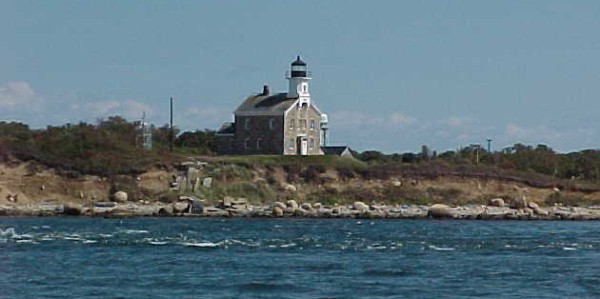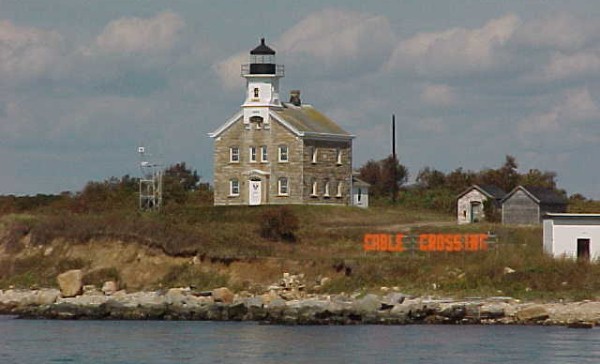Save The Plum Island Lighthouse

After 23 years of abandonment and
neglect, there's now hope for the 1869 lighthouse on the west end of Plum Island. Please
take a few minutes to learn the history of the island and light station, what's now being
done and how you can help.
[History of Plum Island] [About Plum Gut] [History of the Light Station]
[What's Being Done
to Save the Lighthouse] [The Goal]
[How You Can Help] [How to Stay Informed About the Effort]

On the left foreground you can see
the remains of a generator/search light house. This structure fell into the sea in the
late 1990's as a result of the continuing erosion. If the erosion is not stopped, it will
one day claim the lighthouse.
History of Plum Island
Plum Island is an 840-acre island off
the tip of Long Island's North Fork. It was created by the same glacial action that
created Long Island about 15,000 years ago. The first "owner" of Plum Island was
Samuel Wyllys who reportedly "bought" the island, known to the Indians as
Manittuwand, in 1659 from the Indian chief Wyandanch. The purchase price was "one
coat, one barrel of biscuits and 100 fish-hooks." Wyandanch was one of four brothers
and there was a dispute over whether he had the right to sell the island without their
consent. In 1665, the Town of Southold bought the island from one of Wyandanch's brothers.
Eventually, Wyllys's claim was victorious when Wyandanch's brothers died and left him as
the only chief for the four tribes. In 1675 Wyllys received a patent of confirmation for
"Plumme Island" from New York's Governor, Edmund Andros.
Wyllys sold the island in 1699 to
Joseph Dudley for 250 New England pounds. In 1700, Dudley sold the island to Joseph and
William Beebee, who then sold the island in 1732 to Daniel Tuthil for $1700.
In 1775, Plum Gut was the site of the
first battle between British and Continental troops. General George Washington ordered
General Wooster and his troops to land (near the site of the present lighthouse) to
prevent livestock raids by the British. The landing party was quickly repelled by the
British and returned to Oyster Ponds (now Orient Point) under fire. This was the first
amphibious landing under fire by American troops.
The federal government bought 150 acres
on the west end of the island in 1897 from Abraham Hewitt for $25,000 for the erection of
Fort Terry, a military post which was part of a network of artillery posts intended to
protect the area from naval attack during the Spanish-American War (The other posts were
Fort Michie on Great Gull Island, Fort Wright on Fishers Island, and Fort Tyler on the
site of the former Gardiner's Point lighthouse. None of these posts ever fired a shot
other than for practice). After the Spanish-American War the government bought the rest of
the island.
In 1930, the Justice Department
considered making a 1000-cell prison on the island, but the deal never went through. It
was deemed impractical.
Fort Terry was deactivated after WWII,
but was reactivated in April of 1952 for "Chemical Corps activities." In July of
that year, the Agriculture Department established a research center for hoof and mouth
disease in cattle. After spending $4 million on the chemical warfare facility, the Army
turned it over to the Agriculture Department in 1954. The USDA's Plum Island Animal
Disease Center (PIADC) animal disease research center has continued on to this day and is
the reason the island has been off-limits to the public for 45 years. In 1999, it was
announced that the PIADC would like to upgrade the facility to deal with more dangerous
organisms.
About
Plum Gut
Plum Island is separated from
Orient Point by a mile-wide waterway called Plum Gut. Through this waterway passes much
of the tidal water of the Long Island Sound (It shares this duty with The Race,
another dangerous waterway further east between Little Gull Island and Fishers Island).
Because of the venturi effect caused by the narrow waterway, currents often run as high as
four or five knots. The shoals in the Gut, aside from being a danger to ships in
themselves, cause waves as high as six feet as tidal waters pass over them.
History of the Plum Island Light Station
In August of 1826, the Local
Superintendent of Light-Houses at Sag Harbor issued a call for proposals for the
construction of "a Light-House and Dwelling-House on Plumb Island." The
specification for the station included a 30-foot tall octagonal pyramid tower built of
rough stone and a separate keeper's quarters. The tower's lantern was to cast iron and
fitted with Winslow Lewis's patent lamps. In 1856, the lighting apparatus was changed to a
fourth order Fresnel lens.
By the late 1860s, the original light
was in poor condition and it was rebuilt in 1869-70. The new light, which still stands, is
of the same design as other area lights such as Block Island North, Morgan Point,
Sheffield Island, Great Captain's Island and Old Field Point. The original keeper's
quarters remained on the site until they were taken down in 1882.
In 1899, the Orient Point lighthouse
was built on the western side of the Gut and the two served mariners navigating the
waterway for 79 years. In 1978, the lighthouse was decommissioned and has since fallen
into a state of disrepair. In 1994, the lighthouse's 1897 Fresnel lens and clockwork
mechanism were removed and are now on display at the East End Seaport Museum in Greenport.
While the USDA owns the property, it
has not maintained the lighthouse in accordance with the National Historic Preservation
Act of 1966. The structure has been, and still is, threatened by neglect, and erosion
of the bluff upon which it stands. In the late 1990s, a generator/search light house at
the station fell into the water. With the many storms that hit the area, including
hurricanes, tropical storms and nor'easters, the future of the lighthouse is uncertain.
What's Being Done to Save the
Lighthouse
The Long Island Chapter of the US
Lighthouse Society is now leading a restoration effort for this light. Among the steps
underway are the following:
The Chapter has procured a free
source of rocks for bluff stabilization, saving the public an estimated $500,000.
In response to pressure from the
public, and the Chapter, the USDA has nominated the lighthouse for the National Register
of Historic Places.
The light's complete history is being
researched.
Federal, State, County and Town
officials have been contacted and their assistance has been requested. The Town of
Southold has made the restoration of the lighthouse a priority in their waterfront
revitalization program. Senator Charles Schumer and Congressman Felix Grucci are providing
assistance with our efforts.
The support of former keepers is
being sought. Former keepers Bill Scheuber, Tony Tuliano, Les Walter, and Dwight Porter
are already actively supporting our efforts.
The support of lighthouse lovers
everywhere is being sought.
The support of other lighthouse
preservation societies is being sought.
Magazine and newspaper articles are
being written. Such an article, by Merlon Wiggin and Robert G. Muller, appeared in the
January 2000 issue of Lighthouse Digest. Recent newspaper articles have appeared in
Newsday, Long Island Boating World, Suffolk Life and The Suffolk Times.
The Goal
The goal of this effort is to have the
lighthouse, related artifacts, and surrounding property preservd in accordance with the
National Historic Preservation Act. The stabilization of the bluff is the main priority.
How
You Can Help
Public support is needed for this
project. If you'd like to help in any way, please contact the Long Island Chapter of the
US Lighthouse Society at:
29745 Main Road, Cutchogue, New York 11935
How to Stay Informed About the Effort
Long Island Chapter members will be kept informed
through Chapter publications and the Long Island lighthouses e-mail list. Click Here
to join the free e-mail list. Updates will also be posted on this site.

Text and code on this page Copyright © 1999-2001 Robert G. Müller. Photographs courtesy of Diane Mancini. The text and photographs on this page
may be used in non-commercial ways, but please contact the above individuals, as a
courtesy, if you do so. Thanks. :-) |